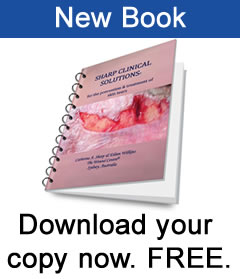Managing the chronic wound environment with Hydration Response Technology; Excerpt from a case study
Mr S. an elderly, obese, gentleman was admitted for assessment and management of bilateral lateral malleolar leg ulcers. The patient’s legs were grossly oedematous with virtually circumferential, severe, bilateral, sloughy, malodorous, maceration of the peri-wound skin. (Figures 1-3)
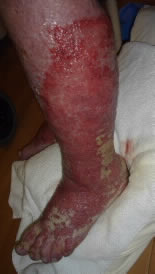 |
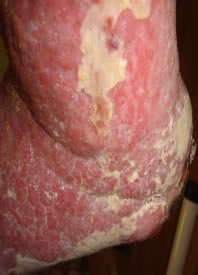 |
|
| Fig. 1 Left leg Day 0 | Fig. 2 Close-up of Left lateral malleolus |
The production of exudates was unrelenting so that dressings and bed linen required at least daily changes and sometimes night changes as well. Dressing change took more than an hour each time to complete, often requiring the assistance of a second nurse.
If a (chronic) wound is to make progress then the barriers to healing need to be identified and addressed. The persistent inflammation that is found in chronic wounds is a consequence of elevated levels of pro-inflammatory cytokines, proteases and neutrophils2. This is often accompanied by elevated production of exudate. The high levels of exudate combined with the pro-inflammatory mediators result in a detrimental effect on healing, including wound enlargement and damage to the peri-wound skin such as maceration and excoriation3. It has been suggested that the wound bed preparation (WBP) model may assist in overcoming these barriers to healing when targeted therapeutic measures are initiated1.
Hydration Response Technology
A recent publication by Evans4 shows how sorbion sachet S utilises the concept of Hydration Response Technology (HRT) and specifically its value in managing infection in a recalcitrant pressure ulcer. Hydration Response Technology was created specifically to meet the challenge of wounds which produce moderate to high levels of exudates.
Clinical performance and related evidence
Hydration Response Technology using sorbion sachet S enables effective wound bed preparation and can lead to a significant reduction of overall treatment costs4,5,6,7. Efficient management of exudates extends beyond mere absorption and includes,:4, 5, 8, 9
|
Table 1
Read the full article and see more photographs of the progress of this gentleman’s leg ulceration in Sharp C.A. Managing the wound environment with Hydration Response Technology. Wounds UK 2010 Vol 6, No 2 and on the website http://www.sorbion.com/en/clinical-data/
References 1. Schultz GS, Barillo DJ, Mozingo DW, et al. Wound bed preparation and a brief history of TIME. Wound Repair and Regeneration 2004; 1(1):19-32. 2. Wolcott RD, Rhoads DD, Dowd SE. Biofilms and chronic wound inflammation. Journal of Wound Care 2008; 17(8):333-341. 3. Nelson A. Is Exudate a Clinical Problem. In: (Eds.) Cherry, G., Harding, K. Proceedings, Joint Meeting, European Wound Management Association and European Tissue Repair Society. Management of Wound Exudate. London:. Churchill Communications Europe 1997. 4. Evans J. Hydration response technology and managing infection. Journal of Community Nursing 2010; 24(1):15-16. 5. Romanelli M, Dini V, Bertone M. A pilot study evaluating the wound and skin care performances of the Hydration Response Technology dressing: a new concept of debridement. Journal of Wound Technology 2009; 5:1-3. 6. Chadwick P. The use of sorbion sachet S in the treatment of a highly exuding diabetic foot wound. The Diabetic Foot Journal 2008; 11(4):183-186. 7. Cutting KF, Acton C, Beldon P, et al. Clinical evaluation of a new high absorbency dressing. EWMA conference, Lisbon 2008; 14-16 May. 8. Cutting KF. Managing wound exudate using a super-absorbent polymer dressing: a 53-patient clinical evaluation. Journal of Wound Care 2009; 18(5):200-205. 9. Armitage M, Macaskill C. Simplifying the management of complex chronic leg ulcers. Poster presentation – Wounds-UK 2009; Harrogate.Wound care for a facial ulcer; a case study.
Introduction
Wound care for facial ulcers can be challenging. The site of the ulcer; appearance; social factors; pain control; availability of wound dressings; amount of exudates and patient tolerance, all impact on the choice and combination of dressings.
Ulcers on the face are often very difficult to dress for several reasons:
- Patients don’t want to see the ulcer;
- They want the ulcer to be ‘hidden’;
- At the same time they want to look reasonable for their family & visitors;
- Discrete dressings are the obvious choice…but what?;
- It is difficult to disguise ulcers as they get larger and deeper;
- Ulcers may be extremely painful;
- Ulcers may bleed;
- There may be exudates that require thick absorbent dressings;
- Bulky dressings can interfere with vision and eating;
- Even small dressings can interfere with eating and drinking;
- Dressings may become contaminated with food thus requiring more frequent changes.
This case study serves to give healthcare workers and / or families, some ideas that may be helpful; nothing is set in stone. There is not one particular wound dressing for a facial ulcer and whatever combination of dressings you do choose please remember that pain control is an absolute priority.
Case Study
Ms. M. L., an elderly patient, has a deep, painful, malignant ulcer of the left top lip. (Photo 1) The ulcer showed evidence not only of destruction of surface tissue but it had almost eroded through the lip. It was not possible to determine the extent of the erosion because she would not allow examination of the underside of the lip.
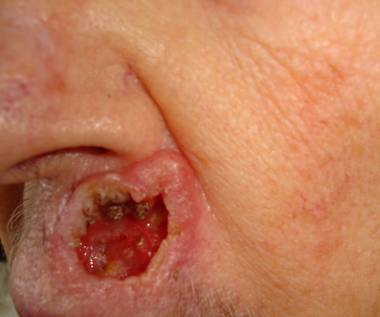
Photo 1 Ulcer top left lip just under the left nostril.
Ms. M. L’s. pain was well managed by her general practitioner in consultation with a pain management team. Analgesia included topical morphine gel into the ulcer crater. This seemed to give great relief.
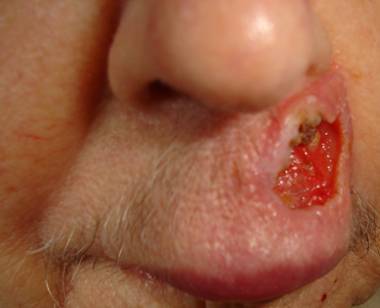
Photo 2 Hairs on the top lip
Photos’ 1 and 2 show the ulcer as well as numerous hairs on the top lip. The hairs made the choice of dressings / tape to secure dressings, difficult and shaving or clipping the hair was not an option.
Objective of wound care
- There was no chance of this ulcer ever healing so the main objectives were to:
- Reduce the ulcer pain;
- Fill the ulcer crater with a primary dressing that would ‘take up space,’ cover nerve endings, absorb exudates and not ‘stick’;
- Cover the ulcer and secure the primary dressing with a non-traumatic dressing i.e. a dressing that would not pull the hairs out of the skin on removal;
- Make sure the dressing stayed in place and did not interfere with eating and drinking;
- Ensure that as few dressing changes as possible would be required.
What did we do?
Fortunately the wound bed did not require cleaning. Even if it had it was unlikely that Ms. M.L. would have allowed any nurse to touch the ulcer. The lips and chin sometimes required a gentle wipe to remove dried exudates and / or food.
Morphine gel was put into the ulcer then a small piece of Aquacel was ‘dropped in’ to take up about 80% of the ulcer. (Photo 3) There was no packing or pushing to get it in.
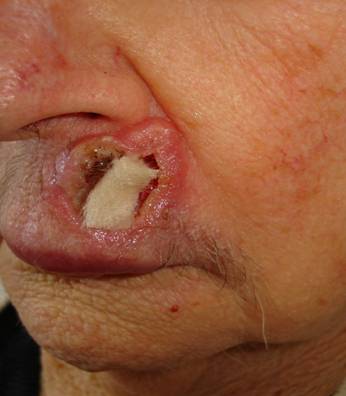
Photo 3 Aquacel in the ulcer
Aquacel is a primary wound dressing made from sodium carboxymethylcellulose.
The dressing absorbs and interacts with wound exudates to form a soft, hydrophilic, gas-permeable gel that traps bacteria and conforms to the contours of the wound.
http://www.dressings.org/Dressings/aquacel.html

Photo 4 Top lip covered with Mepilex Lite
We then covered the top lip with Mepilex Lite, (Photo 4) a conformable absorbent self-adhesive dressing which consists of a thin flexible sheet of absorbent hydrophilic polyurethane foam. The wound contact surface of the dressing is coated with a soft silicone adhesive layer which adheres to the peri-wound skin, retaining the Aquacel dressing in position.
http://www.dressings.org/Dressings/mepilex-lite.html
Did it work?
Aquacel was a perfect primary dressing as it was able to be ‘dropped into’ the cavity without touching the ulcer. Equally I believe an alginate would have been perfectly suitable.
The need to cover nerve endings, reduce pain and fill the deep cavity wound without ‘packing’ was necessary and quite successful. We followed manufacturer’s recommendations to fill about 80% of the ulcer to accommodate swelling from exudates. Aquacel was held in place with Mepilex Lite a secondary dressing.
Mepilex Lite was perfect for this lady’s frail, compromised skin. It hid an unsightly, embarrassing ulcer and did not interfere too much with eating and drinking. It was fairly easy and atraumatic to remove, unlike strong adhesive dressings and tapes which would no doubt have pulled the hairs out of Ms. M. L.’s skin, causing unnecessary pain.
There is no conflict of interest. I have not been paid by any company to write this article, nor am I paid to promote these products in any healthcare facility.
Some details have been altered slightly for patient confidentiality.
I am not qualified to comment on the pain management regime.
Methicillin-resistant Staphylococcus aureus
There is a lot of talk around the world about introducing new categories to describe the degree of infection in chronic wounds e.g. ‘critical colonisation.’
I wonder if we should just get an understanding of the basics i.e. transmission of organisms and cross-infection and correct that first because it is a lack of understanding that kills patients!
A major culprit in cross-infection in all types of healthcare facilities is methicillin-resistant Staphylococcus aureus (MRSA). It is endemic in tertiary referral hospitals in the developed world. [1] The first Australian isolation was made at the Royal Prince Alfred Hospital (RPAH) in Sydney, Australia , in 1965. [2]
So what is MRSA and how can we stop the spread of this potentially deadly nosocomial (hospital acquired) pathogen that has become resistant to so many antibiotics? It is a problem particularly for susceptible patients: neonates, immune suppressed and those undergoing surgical procedures. It can cause infection in wounds, urinary tract, blood and lungs to name but a few sites in the body.
Staphylococcus aureus, which ordinarily lives in the nose and skin of humans, is a harmless berry-shaped (cocci) organism.
Staphylococcus aureus causes problems when it enters what is normally a sterile body site e.g. the bloodstream, urinary tract and wound tissue. If the host (the patient) cannot destroy the numbers of bacteria the result may be, for example, a bloodstream infection (bacteraemia), a urinary tract infection or a wound infection. A wound may exude frank pus as seen in this pressure ulcer.
In fact Staphylococcus aureus was discovered in pus from surgical abscesses in Scotland in 1880 by Sir Alexander Ogston, a surgeon but it was many decades before penicillin became available to treat patients.
PENICILLIN
When penicillin became available in the early 1940s the prognosis for patients with staphylococcal infection improved radically. Unfortunately within a couple of years the first penicillin-resistant staphylococci were recognized, first in hospitals and subsequently in the community. [3] Resistance to penicillin continued to grow, prompting scientists to develop methicillin, the first semi-synthetic penicillinase-resistant penicillin in 1961. Soon after its introduction however, there were reports of methicillin-resistant Staphylococcus aureus (MRSA). [4]
HOW IS MRSA SPREAD?
You are probably all aware that one of the main ways that cross infection occurs is poor hand hygiene. When healthcare workers move from one task or patient (e.g. bed-making) to another (e.g. changing a wound dressing) without hand-washing or hand-rubbing with an alcohol based solution*, pathogenic (disease causing) organisms such as MRSA can be spread andcan be deadly!
(* see hand hygiene, infection control and bed-making )
But when you think about it, unclean hands are only one mode of spread. Anything; bed-linen, clothing, sphygmomanometer cuffs, tourniquets, rolls of tape used to secure dressings — any object that can harbor pathogenic microorganisms (e.g. MRSA) can serve as an agent of transmission of infection.
Collectively these objects are known as ‘fomites’. Look at all the fomites that are used on patient after patient and NEVER CLEANED!!! —- tourniquets and sphygmomanometer cuffs…
Mary Beard demonstrated, in 1969, how new sphygmomanometer cuffs became highly contaminated with pathogenic micro-organisms soon after their introduction into wards at RPAH. [5] Still, they are never washed between patients. I have never known of any healthcare facility where routine practice is for patients to have their own clean sphygmomanometer cuffs (until they acquire MRSA- then they are isolated with their own equipment) …..Strange!!! Seems a bit back-to-front to me!!
‘When such a potential source of sepsis is unrecognized the risks of transmission become magnified as no steps are taken to minimize them.’ [5]
We give patients clean sheets and clean gowns. There would be an outcry if ever we used the same unwashed gown on two patients never mind hundreds or thousands of patients! Yet the same sphygmomanometer cuff is wrapped around arm after arm after arm… gathering more and more bugs.
And 40 years after Beard’s [5] research , testing again carried out at RPAH, showed MRSA to be present not just on sphygmomanometer cuffs and tourniquets, but on scissors, sink basins, taps, soap dispensers and the nurses station. [1] So even the most diligent healthcare worker who washes his or her hands has no hope of stopping cross-infection if they have to handle dirty equipment!
References
1. Barakate MS. Harris JP. West RH. Vickery AM. Sharp CA. Macleod C. Benn RA. A prospective survey of current methicillin-resistant Staphylococcus aureus control measures. Australian and New Zealand Journal of Surgery. 1999; 69(10):712-6, Oct.
2. Barakate MS. Yang YX. Foo SH. Vickery AM. Sharp CA. Fowler LD. Harris JP. West RH. Macleod C. Benn RA. An epidemiological survey of methicillin-resistant Staphylococcus aureus in a tertiary referral hospital. Journal of Hospital Infection. 2000; 44(1):19-26, Jan.
3. Rammelkamp CH, Maxon T. Resistance of Staphylococcus aureus to the action of penicillin. Proc. Royal Soc. Exper. Biol. Med. 1942;51:386–389.
4. Jevons MP. “Celbenin”-resistant staphylococci. Br. Med. J. 1961;1:124–125.
5. Sphygmomanometers as a reservoir of pathogenic bacteria. Beard MA. McIntyre A. Rountree PM. The Medical Journal of Australia 1969; 2: 758
HiCare™ Bath, Making Beds & Infection Control
We have introduced the HiCare ™ Bath technology elsewhere on this site and have said that one advantage of bed-bathing patients using HiCare ™ Bath cloths is that the sheets don’t get wet, as they do with conventional bed-bathing and bowls of water.
When you think about it the [conventional] bowl of water, to bed-bath a patient, rapidly becomes a ‘bacteria soup’ as soon as you dip the washcloth into the bowl.
Bugs are being transferred from one part of the body, to every other part as you move the washcloth from the face to the feet!! Then you have to carry the bowl to the pan-room to pour the [bacteria soup] water out – aerosolising the water and the bugs!!
Who needs it? Use HiCare ™ Bath instead. Sheets may not need to be changed and laundered — saving time, money and water!
Not having to change sheets means there are fewer opportunities for micro-organisms to be dispersed into the air as sheets are pulled off the bed and (thrown!) into the linen skip.
Micro-organisms flying through the air will land on you, the other patients, curtains, trolleys and fomites such as tourniquets and sphygmomanometer cuffs.
Read more about these infection control issues on this website, in particular fomites and methicillin-resistant Staphylococcus aureus (MRSA) , a major culprit in cross-infection.
Meanwhile a few tips to reduce cross-infection when changing sheets:
Why not print off the table & paste it in the linen cupboard, pan room – give each of your staff a copy!! Help them to help themselves.
| Do’s | Don’ts |
| • Remove sheets from the bed slowly – keep the bugs in | • Do not pull sheets off the bed at speed – this will disperse bugs |
| • Place in linen skip slowly | • Do not throw sheets into the skip |
| • After removing sheets from the bed, clean your hands with a waterless ethanol gel /liquid | • Don’t touch the clean sheets until you have cleaned your hands with a waterless ethanol gel /liquid |
| • If the sheets are wet/soiled with urine, blood, faeces etc, wash your hands under running water first | • Do not touch anything with hands that have been in contact with urine, blood, faeces etc.– this will just spread bacteria |
| • Keep clean & dirty linen separate (trolley & skip) | • Do not balance clean sheets on top of the dirty skip to push around |
| • Please put pillows and bedspreads on a chair | • Don’t put pillows and bedspreads on the floor or another patient’s bed |
Why use an alcohol gel handrub?
- The concentration of ethanol will kill bacteria on the hands without making your skin dry and sore
- I find the alcohol gel is much kinder to my skin.
- Using ethanol gel is equal, or superior, to hand washing liquid & water
- It’s fast – rubbing an ethanol gel on your hands between every patient care activity takes a matter of seconds
- Going to a hand-basin to wash and dry hands takes much longer – perhaps that is one reason why it isn’t done as often as it should be
HiCare ™ Bath
This is the first (& only) paid advertisement for a product on The Wound Centre ® website. We have accepted this advertisement on the HiCare ™ Bath system for many reasons:
• It is a wonderful skin-cleansing product
• It is an Australian product
• Australia is suffering from a water-shortage (as many of you in other countries may be also) therefore the timing is perfect to launch this
wonderful product.
• It replaces the traditional bed-bath where nurses carried (OH&S issue) bowls of water which really are a bacteria soup (infection
control issue!)
• HiCare™ Bath washcloths save time
• Towels are not required therefore laundry costs are reduced
• Sheets won’t get wet, as they do during a bed-bath, therefore may not need changing as often, again reducing laundry costs
• It is a wonderful alternative for patients who find showering simply exhausting (those with respiratory disorders)
• For the frail aged at risk of skin tears (manual handling risk – OH&S)
• For those with dementia who may be terrified in the shower and sustain skin tears as a result.
To discuss further just contact Neil at Human Technologies:
Tel: (61) 2 4325-0996 or 1300 653673
Fax: (61) 2 4324-3997
e-Mail: hutek@bigpond.net.au
Web: www.humantechnologies.net.au
National launch of HiCare™ Bath – for ‘no water’ patient bathing
Introduction
HiCare™ Bath is an Australian owned and developed disposable pack of washcloths for bathing patients. The washcloths are impregnated in a pH friendly soap free solution which contains surfactant cleansers, emollients, Vitamin E, an alcohol free fragrance and treated de-ionised water. There is only one chemical preservative (found in some brands of contact lens solutions).
The thick, disposable non-woven, practical size, soft cloths are available in sealed packs of 8 cloths for a full bath or 4 cloths for a birdbath/post op wash. The packs can be micro-waved for a warm bed-bath, cooled, or used at room temperature depending upon patient preference. As well as being very gentle on the skin, the solution also removes pre-operative skin antiseptic solutions.
Indications for use
The HiCare™ Bath washcloths are an alternative to the traditional ‘sponge bath’. They are designed for patients who cannot be showered or when showering is unsafe. For example, patients in high dependency and palliative care units, those suffering cognitive impairment who display resistive behaviours and patients with respiratory disorders who become exhausted in the shower because they simply cannot breathe.
We believe that using HiCare™ Bath can reduce the potential for back injury in staff by providing an alternative to lifting and manoeuvring patients in and out of the shower. We are also convinced that the incidence of skin tears, an increasing problem for the frail-aged, will decrease because manual handling can be reduced.
Cost Savings
HiCare™ Bath is the ideal ‘no water’ solution in those countries with water restrictions. Using HiCare™ Bath washcloths will result in considerable reductions in bathing time and costs. Towels are not required and the need to frequently change bed-sheets is reduced therefore laundry bills will be slashed.
Independent Qualitative and Quantitative Repeat Skin Patch Testing in the USA
The HiCare™ Bath solution was independently tested by Cantor Research Laboratories in the USA in 2005. Testing involved 52 people of different ages and races. No sensitivity or allergic reactions were reported. A full report or one page document is available (e-Mail upon request hutek@bigpond.net.au).
The future
International: Human Technologies (Aust) Pty Ltd intend to seek expressions of interest for the importation of HiCare Bath into other global markets this year.
Domestic: Human Technologies (Aust) Pty Ltd have a distributor network in each State of Australia and sell direct to the ‘at home’ consumer market for palliative care.
Please contact direct :
Human Technologies (Aust) Pty Ltd.
PO Box 1841,
Gosford NSW 2250
Australia
Tel: (61) 2 4325-0996 or 1300 653673
Fax: (61) 2 4324-3997
e-Mail: hutek@bigpond.net.au
Web: www.humantechnologies.net.au

